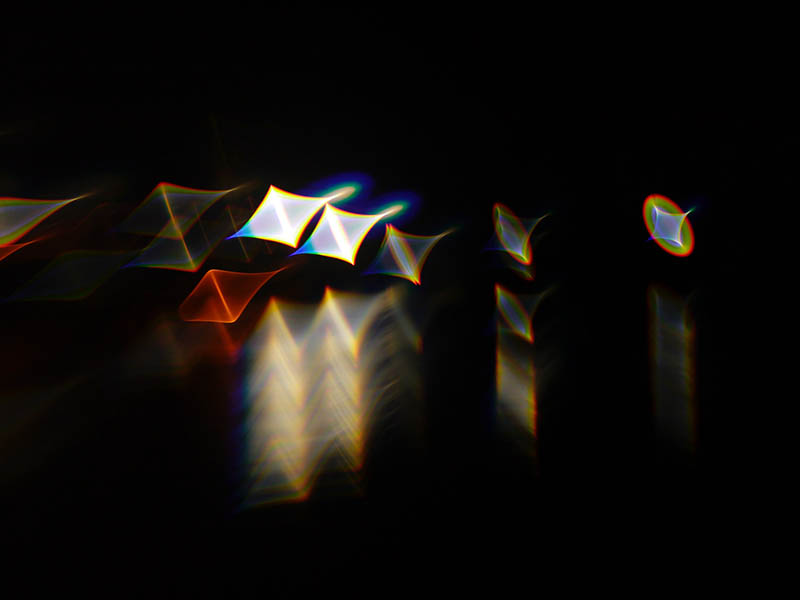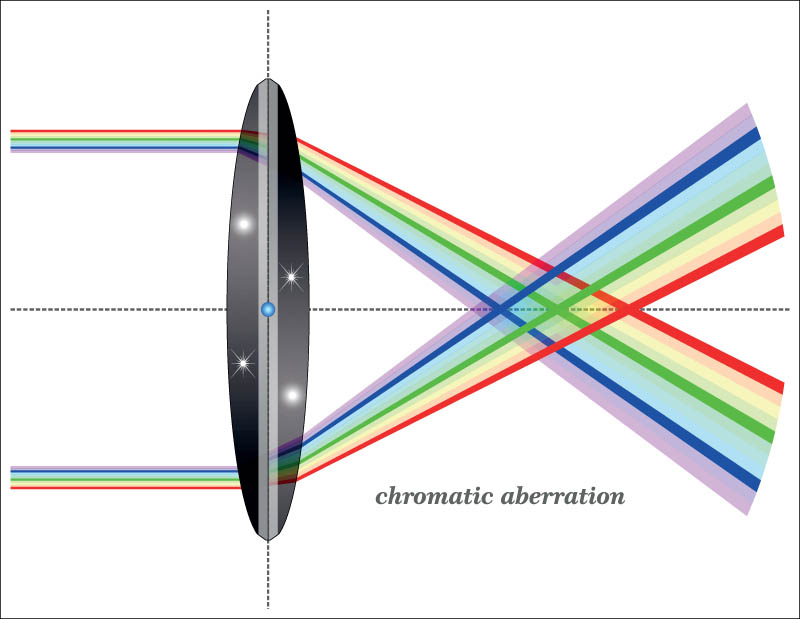What Is Chromatic Aberration and How Do I Fix It?
Last Updated on

Chromatic aberration, also known as color fringing or purple fringing, is a common optical issue that happens when the lens can’t bring all the wavelengths of color onto the same focal plane. It can also occur if the wavelengths of color are focused in different positions.
The lens acts as a prism, bending light, and colors are split at different angles. Essentially, this means that the colors are “bent” by the lens, creating a mismatch that doesn’t allow the colors to combine the way they should. The focal plane is the point of focus, and when things go correctly, the light from the lens joins together.
When this happens, it can ruin your photography and create an unappealing look in a photo that must be corrected by photo-editing programs like Photoshop. It’s much easier to prevent or minimize chromatic aberration than correct it after the fact.

What Causes Chromatic Aberration?
When chromatic aberration occurs, it looks like an outline of undesirable color on the edges of the objects in a photograph. Typically, it appears along metallic surfaces or in areas with a stark contrast of light and dark colors.
Remember, light is made up of different colors. The camera’s sensor has to detect the colors in the light, and the lens needs to direct all those color wavelengths into the exact point on a sensor. Though all these wavelengths hit the lens at the same time, they behave differently as they pass through the lens glass.
In most cases, the alignment of the different wavelengths is achieved during the manufacturing process with a lens array. These lenses are constructed with multiple layers of lens elements to automatically adjust and correct for variances that impact the light’s travel between the lens and the sensor, such as chromatic aberration.
But no lens array is perfect. Any small defect in the lens design or the lenses themselves can cause chromatic aberration. This isn’t only an issue with low-quality lenses, either—any lens can cause chromatic aberration under the right circumstances.
The different types of aberration can lead to different color outlines due to the refractive index of glass. A camera fails to focus the different wavelengths of light on the same focal point, which could cause blue-yellow, red-green, or magenta-purple fringing.

What Are the Different Types of Chromatic Aberration?
Chromatic aberration may occur along an axial (longitudinal) surface or a transverse (lateral) surface. The former occurs when the different wavelengths of light are focused at different distances from the lens. This is common with long focal lengths.
The latter occurs when the different wavelengths are focused at different positions on the focal plane. Magnification or distortion of the lens varies with the wavelength, which is typical at short focal lengths. These types of chromatic aberration may happen together or independently.
How to Prevent Chromatic Aberration
You don’t need pro-level lenses, but chromatic aberration will occur more with cheap or poorly manufactured lenses. But whatever lens quality you have, you can employ some strategies to minimize its impact on your final product.
1. Avoid High-Contrast Photos
Chromatic aberration is most likely to occur when you’re shooting high-contrast subjects and backgrounds. This is especially true with dark subjects and white backdrops, such as a bright sunrise with a dark building.
There’s not much you can do to tweak the contrast in a setting, but you can adjust your composition to discover less contrast. Or you can wait until the subject isn’t as heavily backlit. Worst case, shoot your subject and correct the chromatic aberration in photoshop.
2. Adjust the Focal Length
A wide range of focal length offers a lot of freedom with your photography, but you’ll also encounter more chromatic aberration. Zoom lenses are particularly prone to chromatic aberration at their extremes. Instead of pushing the limits, set the focal length near the middle of the range.
Zooming the lens at its widest may not affect chromatic aberration, but it can introduce other defects. If you’re keen on a wide-angle perspective, invest in a premium wide-angle lens or create a panorama at a long focal length and edit them together.

3. Stopping Down
Stopping down the aperture minimizes defects like chromatic aberration. Note that you may need to adjust the shutter speed to compensate for the loss of light. Consider shifting from an f/2.8 or an f/4 aperture to an f/8 or f/11 aperture, then test the shots to see if chromatic aberration is still a problem.
4. Reframe the Subject
Chromatic aberration is more noticeable near the frame’s edges, not at the central focal point. This is due to the lens curvature. So, if you reframe your shot to keep your subject closer to the center, you may resolve the issue of chromatic aberration.
You’ll still see some chromatic aberration on the edges of the frame, but that can be cropped out more easily than correcting chromatic aberration with Photoshop. In most cases, cropping won’t be noticeable or have a major impact on your overall composition.
5. Use an Achromatic Lens
An achromatic lens corrects to concentrate two wavelengths—usually red and blue—on the same plane. This is done using a doublet that consists of two separate lenses with different degrees of dispersion. A stronger solution is an apochromatic lens, which can separate three different wavelengths of light.
6. Choose Cameras with Solutions for Chromatic Aberration
Some high-quality cameras have methods to reduce chromatic aberration, such as a dedicated processing phase for removing fringing. You could also invest in high-quality lenses that have fewer defects, and by extension, less opportunity for chromatic aberration.


Can Chromatic Aberration Be Used as an Effect?
Chromatic aberration is typically something photographers want to correct in post-processing or learn to minimize in the first place. But if that’s not possible, chromatic aberration can be used to create a unique effect.
For example, color fringing creates a sort of 3D or retro look in some photographs. In videos, it can create a psychedelic look or feeling of unsteadiness in an image. It’s up to you how you may be able to make chromatic aberration work, but if possible, learn to minimize it or eliminate it before you test your creativity.
Does Chromatic Aberration Affect Black-and-White Photography?
As mentioned, chromatic aberration is an effect on the wavelengths of color that exist in light, so it may be surprising that it can also occur with black-and-white photography. Even without colors, chromatic aberration can cause a blur to the image that impacts its quality.
This can be reduced by using a narrow-band color filter or by converting a single color channel to black and white. This takes some skill, however, since it requires longer exposure.

Final Thoughts
Chromatic aberration is an often-unpleasant effect that can ruin an otherwise well-done photo. Many photographers struggle with it and don’t know how to correct or minimize it, so they’re stuck fixing it in post-processing. It’s best to make adjustments to minimize chromatic aberration at the start, then fix what you can in post-processing. And if you want to embrace the effect, it’s better to learn how to correct it first. Once you have control over the process, you can create the effect confidently in the future and use it to your advantage.
Featured Image Credit: Meagan Carsience, Unsplash
About the Author Robert Sparks
Robert’s obsession with all things optical started early in life, when his optician father would bring home prototypes for Robert to play with. Nowadays, Robert is dedicated to helping others find the right optics for their needs. His hobbies include astronomy, astrophysics, and model building. Originally from Newark, NJ, he resides in Santa Fe, New Mexico, where the nighttime skies are filled with glittering stars.
Related Articles:
How to Collimate Binoculars: 9 Expert Tips
Binocular Magnification Chart: Numbers & Distances Compared
How to Clean a Refractor Telescope: Step-by-Step Guide
How to Clean a Telescope Eyepiece: Step-by-Step Guide
What Is the Best Binocular Magnification for Hunting? Optical Features Explained
How to Clean a Rifle Scope: 8 Expert Tips
When Were Binoculars Invented? History, Today & Future
Can You Use Binoculars to Look At Stars? How to Choose the Right Pair
